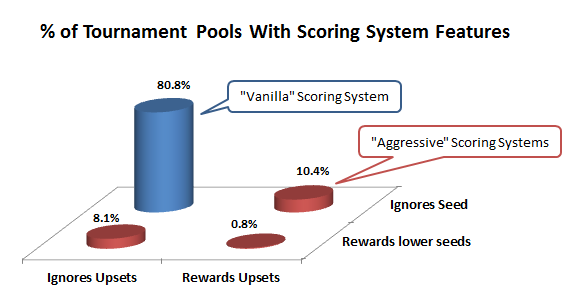The Most Popular (And Crazy) Types Of Bracket Pools
March 14, 2015 - by Aaron Barzilai
It’s that most wonderful time of the year: March Madness, when all of America obsesses over the NCAA Tournament.
By now, the media, coworkers, family, friends and frenemies alike have inundated you with all things March Madness. Articles, tweets, and raging diatribes on the NCAA bracket hit you from all angles — and everyone wants you to enter their bracket pool.
To commemorate the madness this year, we’re doing something new. Using unique data we’ve collected about our customers’ bracket contests, we’re going to share and celebrate all of the amazing varieties of NCAA bracket pools that are out there.
Hopefully, you’ll get some fun new ideas for how to set up your own bracket pool in 2015.
Because when it comes to dreaming up ways to reallocate wealth during March Madness, you all are some seriously creative people. Or just plain insane.
About Our NCAA Bracket Pool Data
Since the prehistoric age of 2000, we’ve pioneered the concept of data-driven bracket picks here at TeamRankings. In recent years, though, we’ve made big leaps forward in the sophistication and scope of our bracket pick analytics.
Today, we ask customers of our bracket picks product for specific details about their pools: the number of entries, the scoring system, the payout structure. Then, we take that data and customize brackets that give each user the best chance to win his or her specific bracket pool.
(In short, few people realize just how much factors like scoring system and pool size affect optimal pick strategy in NCAA pools. And thanks to millions of bracket pool simulations that we run, we’re the only ones who can customize a great bracket for thousands of different pool variations, in seconds.)
For the first time, though, we’re going to share some of the bracket pool data we collected from our customers last year. We took a sample of a few thousand pools, so while the following data may not be exactly representative of all bracket pools in the world, it’s a sufficient amount of information for a high-level study.
Factor 1: Bracket Pool Size
Digging through our data, we took a look at the distribution of how large NCAA Tournament pools are in terms of entries. Looking at the chart below we can see:
- 11% of pools set up in our system had 10,000 or more entries
- Almost 5% more had between 1,000 and 9,999 entries
- On the other hand, about 17% of pools had fewer than 20 entries
- The median pool size was 60 entries
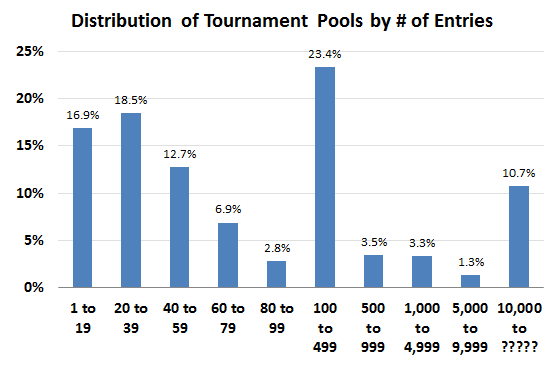
“10,000 or more” was the largest pool size option we gave our customers last year, so it’s not exactly clear what’s driving the relatively big volume of pools at the high end of the pool size range.
We suspect that some of it came from customers entering the Warren Buffett / Quicken Loans billion dollar bracket challenge, or putting entries into the general national contests on big sites like Yahoo! and ESPN.
It also illustrates a quirk in our data set. It’s highly doubtful that 11% of pools nationwide have at least 10,000 people in them, so at larger pool sizes, we almost certainly had a good number of customers all entering some of the same pools. At small pool sizes, this phenomenon should be rare, though.
(By the way, at very large pool size, even though your chances of winning are quite low, your expected long-term profit goes up significantly if you enter portfolios of multiple brackets all with different champions. So we hope those customers all used the “Play Multiple Entries” brackets we include in our NCAA bracket picks product.)
Summing up a few of the bins in the above chart in a slightly different way, we find out that:
- 35.4% of bracket pools had under 40 entries
- 22.4% had 40 to 99 entries
- 23.4% had 100 to 499 entries
- 18.8% had more than 500 entries
Factor 2: Bracket Pool Scoring Systems
If there is one theme from the data in our system, it’s that bracket pool commissioners are very, very creative. Last year our customers, in aggregate, used our product to get customized brackets for over 500 different unique variations of scoring systems.
We can’t possibly detail all the variations, but we’ve provided a summary below.
Reward Upsets Or Not?
- 81% of pools used a “Vanilla” scoring system that simply assigns, by round, a fixed number of points per correct pick. The popular 1-2-4-8-16-32 system is an example of this, where correct Round of 64 picks are worth an almost negligible 1 point, while nailing the NCAA champion nets a whopping 32 points.
- The remaining 19% of pools got more creative, and used approaches we’ll call “Aggressive.” Some incorporated the seed number of a correct pick as an additive or multiplicative factor (e.g. 2 points times the team’s seed number, or 2 points plus the team’s seed number, for each correct pick in the Round of 32).
- Others awarded bonus points for each correct pick that was an upset (e.g. 2 points plus the difference in seed for each correct pick in the Round of 32, if the pick was a seed-based upset).
- A very small handful of pools (0.8%) actually combine both variations in their scoring system. Yikes. (Shameless plug: Our simulation-driven picks are likely to give you an especially large edge in pools with scoring systems this complex, because there’s no way humans can figure out how to optimize for it in their heads
Scoring by Round
- Looking at the base scoring by round that pools applied, a whopping 70% of pools employed a geometric scheme of 1-2-4-8-16-32. This is the default scoring system of big sites like Yahoo! and ESPN, and strategically, it places a big burden on getting your champion pick correct. If you’re in a large bracket pool with 1-2-4-8-16-32 scoring and you don’t get your champion pick right, you can usually kiss your hopes of winning the pool goodbye. (You can sometimes still win smaller pools, though.) Additionally, how you do picking the Round of 64, despite the hype that it always generates, doesn’t mean nearly as much as most people think it does if your scoring is 1-2-4-8-16-32. If you get 27 of 32 first round games right and I only get 24, there’s a not a huge chance that’s going to be a difference maker in the end, especially in smaller pools.
- After a huge dropoff, the next most common approach for round-based scoring was an additive system of 1-2-3-4-5-6, employed by 5% of pools. This type of scoring system is much more tuned for rewarding the overall accuracy of picking all the NCAA tournament games. Picking the Round of 64 well becomes far more important, and missing your champion pick is by no means a knockout blow, especially if a very unpopular champion pick ends up winning it all.
- No other single base scoring system was featured in more than 2% of pools. But we do think 1-1-1-1-1-1 is pretty awesome. We’re also sad that pool scoring based on the Fibonacci sequence (e.g. 1-1-2-3-5-8 or 1-2-3-5-8-13) isn’t more popular, because Leonardo Bonacci (aka Fibonacci) was a badass Italian mathematician and it’s pretty cool that we can honor his legacy with a bracket scoring system.
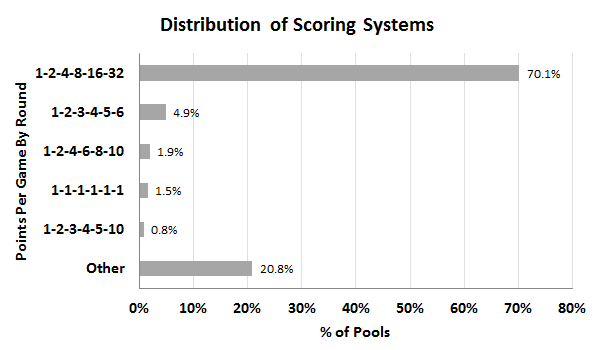
Factor 3: Bracket Pool Prize / Payout Structure
We also looked at how bracket pools pay out money to winners. (Oops did I just say that? Sorry, I meant “how pools distribute bragging rights for entertainment purposes only.”)
Continuing our theme of lots of creativity, our data set of customer bracket pools from 2014 included over 120 different prize structures.
Number of Winners
- The most common prize structure is winner take all, which was used in 30% of bracket pools
- Slightly more than 30% of pools paid out to the top three finishers, but the percentage of the pot that went to each finisher varied a lot
- The vast majority of pools (89%) paid out to 5 or fewer winners
- Only 8% of pools paid out to 10 or more winners
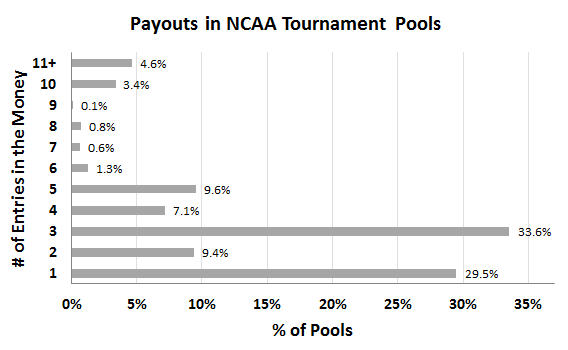
Splitting the Cash Entertainment Units
When it comes to divvying up the greenbacks the day after the NCAA tournament champion is crowned, the pools in our data set split winnings among recipients in a wide variety of ways.
- After winner take all, the second most common relative split (60-30-10) occurred in only 7% of pools
- Grouping the next three most common prize splits in pools that pay out to three finishers (70-20-10, 50-30-20, and 65-25-10) only accounted for 17% of all pools
We also looked at the most common payout splits based on the number of entries receiving a prize. For example, in pools where two finishers won prizes, the most common pot split percentage was 75% to first place and 25% to second. Here’s a bigger list:
- 2 prize slots: 75-25
- 3 prize slots: 60-30-10
- 4 prize slots: 50-25-15-10
- 5 prize slots: 50-20-15-10-5
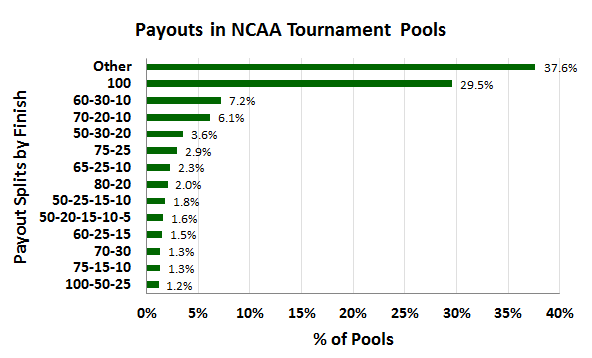
Note that “100” in the chart above represents winner take all.
Factor 4: Play In Games & Sweet 16 (Second Chance) Bracket Pools
The overwhelming majority of NCAA tournament pools in our data set did not include the play-in games (sorry, “First Four”), but did include all remaining rounds of the NCAA tournament.
Still, our tools do support pools that count the play-in games, as well as pools that begin with the Sweet 16. As a result, we know that:
- Only 3.5% of bracket pools include the play-in games as part of their scoring, though usually for very few points.
- Only 4.1% of pools begin with the Sweet 16. This number may increase this year, as the word on the street is that ESPN is preparing to launch a Second Chance bracket contest for the first time.
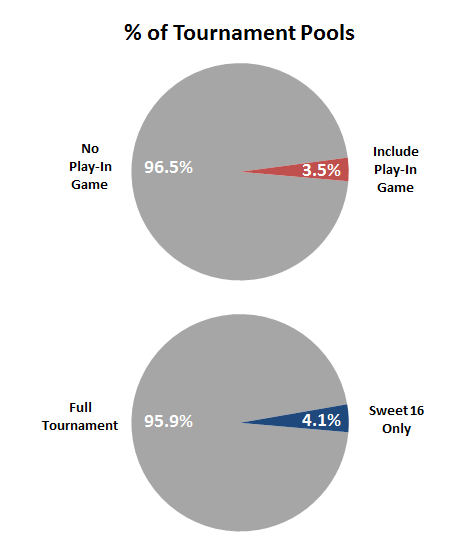
Since Sweet 16 pools and pools that included the play-in games were rare, we did not include data from them in any of the other numbers we quote in this post.
Is Your Head Spinning Yet?
As our customer data shows, pool commissioners set up NCAA bracket pools in a dizzying variety of ways, and that’s yet another reason that makes March Madness so awesome.
It also makes our job — analyzing all these bracket pool variations and training a gaggle of high powered servers over at Amazon Web Services to figure out how to get the biggest edge in every one of them — quite amazingly complicated. But we love the challenge.
Good luck putting together a fun bracket pool in 2015. And if you want the number crunchers from TeamRankings to help you get the maximum edge in your pool, our picks are here.
Printed from TeamRankings.com - © 2005-2024 Team Rankings, LLC. All Rights Reserved.
